Notes
| | This article about French cuisine is a stub. You can help Wikipedia by expanding it. |
Poule, chapon, or poulardeau riz is a dish in French cuisine consisting of a poached or braised chicken served with rice cooked in the chicken's cooking liquid or broth. It is sometimes compared to pilaf. [1]
Some versions cook the rice and chicken together. [2] Others use the broth or juices of a cooked chicken to cook the rice. [3]

Chicken soup is a soup made from chicken, simmered in water, usually with various other ingredients. The classic chicken soup consists of a clear chicken broth, often with pieces of chicken or vegetables; common additions are pasta, noodles, dumplings, or grains such as rice and barley. Chicken soup has acquired the reputation of a folk remedy for colds and influenza, and in many countries is considered a comfort food.
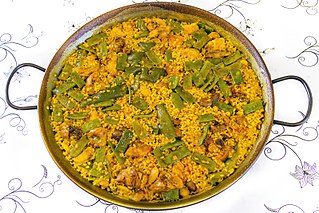
Paella is a rice dish originally from Valencia. While non-Spaniards commonly view it as Spain's national dish, Spaniards almost unanimously consider it to be a dish from the Valencian region. Valencians, in turn, regard paella as one of their identifying symbols. It is one of the best-known dishes in Spanish cuisine.

Phở or pho is a Vietnamese soup dish consisting of broth, rice noodles, herbs, and meat. Phở is a popular food in Vietnam where it is served in households, street-stalls, and restaurants country-wide. Residents of the city of Nam Định were the first to create Vietnamese traditional phở. It is considered Vietnam's national dish.

Avgolemono is a family of sauces and soups made with egg yolk and lemon juice mixed with broth, heated until they thicken. They are found in Greek, Arab, Sephardic Jewish, Turkish, Balkan and Jewish-Italian cuisine.

Noodle soup refers to a variety of soups with noodles and other ingredients served in a light broth. Noodle soup is a common dish across East Asia, Southeast Asia and the Himalayan states of South Asia. Various types of noodles are used, such as rice noodles, wheat noodles and egg noodles.

Chicken feet are cooked and eaten in many countries. After an outer layer of hard skin is removed, most of the edible tissue on the feet consists of skin and tendons, with no muscle. This gives the feet a distinct gelatinous texture different from the rest of the chicken meat.
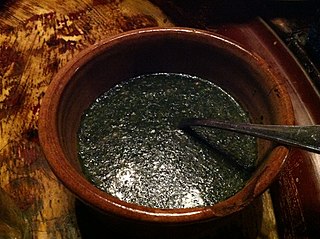
Mulukhiyah, also known as molokhia, molohiya, or ewedu, is a dish made from the leaves of Corchorus olitorius, commonly known in English as denje'c'jute,nalta jute, tossa jute, jute mallow or Jew's Mallow. It is used as a vegetable and is mainly eaten in the Levant, Egypt, Cyprus, Libya, and Tunisia. In some countries it is called “Saluyot” in the Philippines. Mulukhiyah is rather bitter, and when boiled, the resulting liquid is a thick, highly mucilaginous broth; it is often described as "slimy", rather like cooked okra. Mulukhiyah is generally eaten cooked, not raw, and it is either eaten chopped and sautéed in oil, garlic and cilantro like in Syria or turned into a kind of soup or stew like in Egypt, typically bearing the same name as the vegetable in the local language. Traditionally mulukhiyah is cooked with chicken or at least chicken stock for flavor and is served with white rice, accompanied with lemon or lime.

Soups in East Asian culture are eaten as one of the main dishes in a meal or in some cases served straight with little adornment, particular attention is paid to the soups' stocks. In the case of some soups, the stock ingredients become part of the soup. They are usually based solely on broths and lacking in dairy products such as milk or cream. If thickened, the thickening usually consists of refined starches from corn or sweet potatoes.

Haitian cuisine consists of cooking traditions and practices from Haiti. It is a Creole cuisine that originates from a blend of several culinary styles that populated the western portion of the island of Hispaniola, namely the African, French, indigenous Taíno, Spanish and Arab influence. Haitian cuisine is comparable to that of "criollo" cooking and similar to the rest of the Latin Caribbean, but differs in several ways from its regional counterparts.

Kuwaiti cuisine is a fusion of Arabian, Iranian, Indian and Mediterranean cuisines. Kuwaiti cuisine is part of the Eastern Arabian cuisine. A prominent dish in Kuwaiti cuisine is machboos, a rice-based dish usually prepared with basmati rice seasoned with spices, and chicken or mutton.
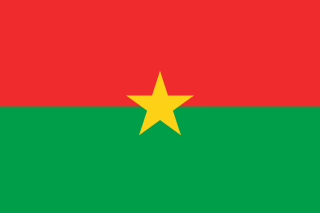
Burkinabé cuisine, the cuisine of Burkina Faso, is similar to the cuisines in many parts of West Africa, and is based on staple foods of sorghum, millet, rice, fonio, maize, peanuts, potatoes, beans, yams and okra. Rice, maize and millet are the most commonly eaten grains. Grilled meat is common, particularly mutton, goat, beef and fish.

Crossing-the-bridge noodles is a rice noodle soup originating from the Yunnan province of China. It is one of the best-known dishes in Yunnan cuisine.

Tiep or thieb is a traditional dish from Senegambia that is also consumed in Guinea Bissau, Guinea, Mali and Mauritania. It is the national dish in Senegal. The version of tiep called thieboudienne or chebu jen is prepared with fish, rice and tomato sauce cooked in one pot. There are also tiep yappa and tiep ganaar. Additional ingredients often include onions, carrots, cabbage, cassava, hot pepper, lime and peanut oil, and stock cubes.
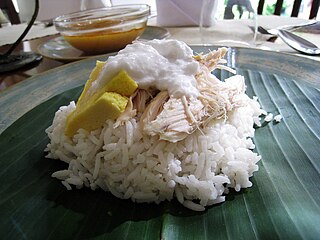
Nasi liwet is an Indonesian dish rice dish cooked in coconut milk, chicken broth and spices, from Solo, Central Java, Indonesia. Common steamed rice is usually cooked in water, but nasi liwet is rice cooked in coconut milk, chicken broth, salam leaves and lemongrass, thus giving the rice a rich, aromatic and succulent taste. Nasi liwet is a traditional Javanese way of cooking rice in coconut milk. There is one variant of liwet rice, the style of Nasi Liwet Sunda from West Java with its unique Sundanese cuisine a different taste and presentation from Sundanese eating tradition called ngeliwet or botram.

Nasi tim is an Tionghoa Indonesian steamed chicken rice. In Indonesian language nasi means (cooked) rice and tim means steam. The ingredients are chicken, mushroom and hard boiled egg. These are seasoned in soy sauce and garlic, and then placed at the bottom of a tin bowl. This tin bowl is then filled with rice and steamed until cooked. This dish is usually served with light chicken broth and chopped leeks.
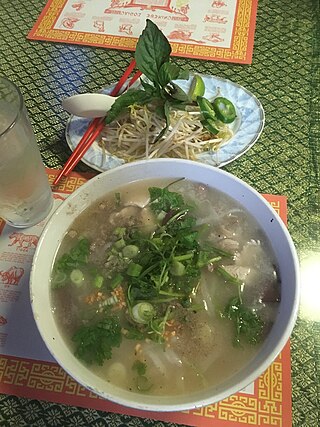
Khao piak sen is a rice noodle soup that is a part of traditional Lao cuisine. It is a common comfort food that's great for a cold day. It is the "chicken noodle soup" of Laotian cuisine and does not require too many ingredients, but makes a perfect dish with its simplicity. It is often made in large batches to eat with a large group of people. It is sometimes prepared using pork belly. Chopsticks are commonly used to consume the soup, and it is commonly eaten as a breakfast dish.

Soto is a traditional Indonesian soup mainly composed of broth, meat, and vegetables. Many traditional soups are called soto, whereas foreign and Western influenced soups are called sop.

Madurese cuisine is a cuisine tradition of Madurese people from Madura Island in Indonesia. This cuisine also known in East Java as well as on the south coast of Kalimantan. Madura cuisine has salty, savoury and spicy tastes with Javanese-influenced.

Indonesian noodles are a significant aspect of Indonesian cuisine which is itself very diverse. Indonesian cuisine recognizes many types of noodles, with each region of the country often developing its own distinct recipes.